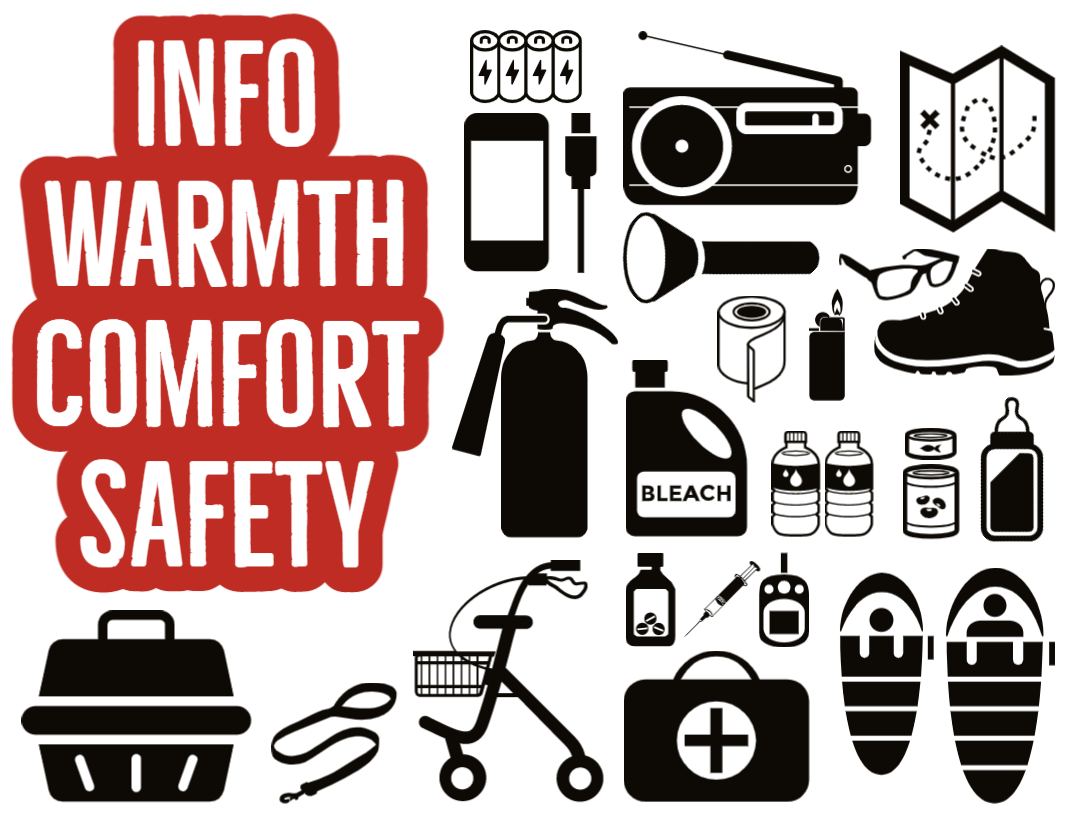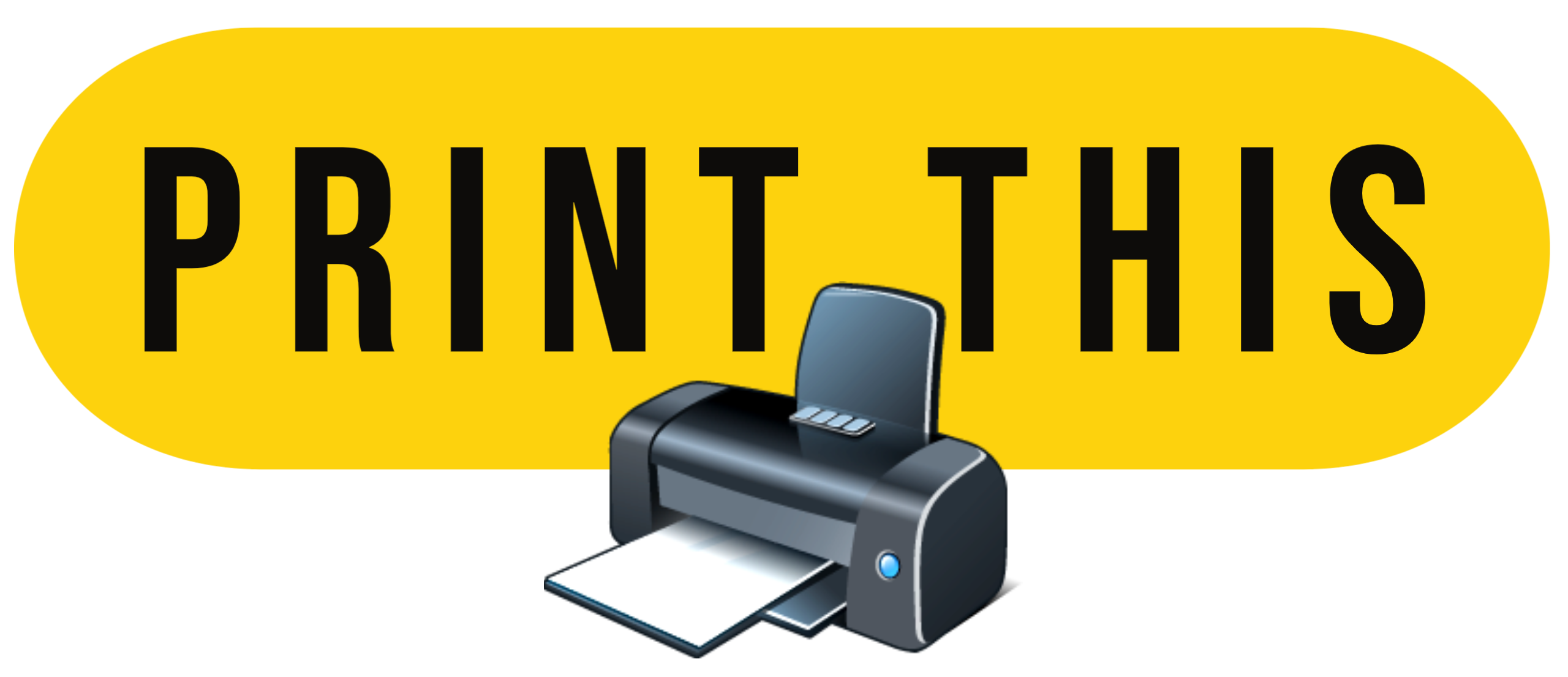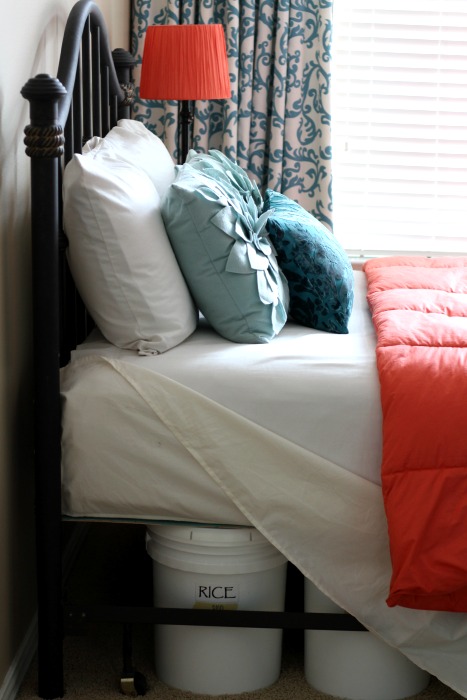Do You Have What You Need?

We All Need Different Things
What if the power goes out, water stops flowing from your pipes, and you can't go to the store? What if you need to evacuate your home or neighborhood quickly? Gather emergency supplies to make sure you and your loved ones can stay comfortable and safe.
Let's Work Together
Work with friends, family, neighbors, and co-workers. See how you can help each other gather and share supplies. Consider your additional needs, children, and pets. Don't forget to have a toilet plan.
This might seem like a lot of work. Some people find it overwhelming. But doing something is much better than doing nothing at all. So start small, but start today.
Focus on the Essentials
Make a list and put it in priority order. Focus on the things that will keep you alive, like water, food, medications, medical supplies, warmth, and sanitation. Next, move on to other supplies that you know you would need in an emergency. Only include the things you know you would use. Since we all have different needs, everyone's emergency kit will look a little different.
We don't know where we'll be when an emergency occurs. Put supplies in places wherever you and your loved ones spend a lot of time.
At Home
If you can, try to have enough supplies available to last you two weeks. Store items in a cool, dry place that you can get to easily. Tell everyone you live with where emergency supplies are stored.
Under Your Bed
You may be sleeping when an earthquake or other emergency happens. Keep a few items under your bed so you can get out of the house and protect you from glass and other debris.
- Slip-on or loosely-laced shoes or boots
- Flashlight (check batteries regularly)
- Hard hat or bike helmet
- Leather work gloves
- A whistle to call for help
In Your Car
Think about what you would need to shelter in place or walk home. Include items like water, food, warmth, maps, etc. Also have car tools, such as a jack, wrench, tire chains, ice scraper, jumper cables, flares, etc. For summer, include extra water, sunscreen, and a sun hat. For winter, include warm clothes, an ice scraper, and chains or other traction devices.
At Work / School
Be prepared to stay put for 1-2 days. Use the lists below and decide what is essential for you. At a minimum, include water, food, a first aid kit, prescription medicine, cash, and a cell phone charger.
On the Go
You may need to leave home quickly. Keep a portable emergency kit in a backpack or other portable container. Keep it near your front door so you can access it easily.
Water and Bleach
Clean water is essential for staying healthy during a disaster. Visit regionalh2o.org for more info about water storage and treatment. At minimum, have:
- At least one gallon per person (and animal), per day, for at least 14 days. That’s 14 gallons per person/animal.
- Unscented bleach and a dropper so you can sanitize unclean water. Use eight drops of bleach per gallon of water.
Shelter and Warmth
Keeping warm and dry is crucial. Blankets and sleeping bags will help you stay warm if the power goes out. A tent, tarp shelter, or car could be used if your home isn’t safe to enter.
You never know what you might (or might not) be wearing when an emergency occurs. Keep clean clothes, sturdy walking shoes, and spare socks in your emergency kit. If you can, include several items for different weather conditions.
You may need to start a campfire for warmth or light a grill for food. Keep lighters or matches in your kit. Put them in a waterproof container. Use Smokey Bear's Campfire Safety Guide. Never do any of this indoors! Carbon monoxide is very dangerous.
Non-Perishable Food
Store food that you like to eat. Get items that will last a long time without refrigeration and are highly nutritious. Protein and whole grains are good. Sugar is not. Keep a manual can opener in your emergency kit if you're storing canned food.
First Aid Supplies
We might need to treat our own wounds if professional help is unable to get to us. Include First Aid items that you know how to use. Consider taking a First Aid class so you can better help yourself and those around you.
Fire Extinguishers
House fires are the most common type of emergency. An earthquake could break gas lines and lead to a house fire. Have an extinguisher in the kitchen and by your front door. Make sure you know how to use it safely.
Medication and Medical Info
37% of Americans can go a week or less without their medications or medical devices before facing a crisis. Think about your additional needs and plan for them.
If possible, store a two-week backup supply of medications and other medical supplies. Include spare glasses or contact lens supplies.
Keep your prescription details (including dosage and prescribing doctor) in your wallet or purse in case you can't access your emergency kit.
Personal and Financial Documents
Put copies of important personal and financial documents in a portable, waterproof container. Store them digitally and/or make photocopies. Use this Financial Preparedness Checklist and check out FEMA's Emergency Financial First Aid Kit.
Don't forget to include several printed copies of your emergency plan. Keep copies in multiple locations so you have it wherever you are.
Emergency Toilet Items
Diseases like cholera can spread when human waste is not stored safely. Have a toilet plan, and read the Emergency Toilet Guidebook. Have buckets, heavy-duty garbage bags, and layering materials on hand, just in case.
Personal Hygiene Items
Keeping clean helps us stay healthy and improves our spirits. Include a toothbrush, feminine supplies, toilet paper, soap, wet wipes, hand sanitizer, unscented bleach, and garbage bags in your kit.
COVID-19 Materials
Even before the COVID-19 pandemic, it was a good idea to include face masks and hand-washing supplies in your emergency kit. Now, it's especially important. Also include items you would need if you get sick, such as extra water and medication.
Infant-Care Items
Diapers, wipes, rash cream, formula, extra clothes, etc. You might already have many of these items in a diaper bag. Store extra water help keep baby clean and prepare formula.
Animal Care Items
For many of us, our animals are an important part of our lives. Make a plan for your pets and livestock. Keep identification tags and microchip info current. Store extra water, food, leashes, cages, medication, photo and paper identification, and bedding in your emergency kit.
Flashlights
The power may go out during an emergency. Candles can be dangerous. LED flashlights are affordable and last longer.
AM/FM Radio
Radios can be powered by batteries, hand-crank, and solar energy. Tune in to 91.5FM or 101.1 KXL-FM for updates. Consider getting a NOAA Weather Radio, which has a loud tone that will alert you when there’s an important update.
Make sure you are signed up to receive emergency alerts by phone, text, and email. And learn about other ways to stay informed during an emergency.
Batteries
Many emergency supplies use batteries. Have plenty available, but store them separately so they don't ruin devices if they leak.
Cell Phone Chargers
Cell phone service might not be available. But if it is, you’ll want to use your phone to stay informed, take photos, and communicate. Get a battery-operated phone charger or one that plugs into your car. If you can afford it, consider buying a solar charger.
Whistles
You may need to signal for help, and it’s hard to shout for long periods. Keep a whistle in each of your kits (home, car, work, under the bed).
Tools and Gloves
A basic tool kit will help you turn off the gas, repair broken windows, or board up your home. Include a hammer, nails, a pry bar, and a multi-tool. There are special tools for shutting of natural gas, but you can also use a regular wrench. Rope and duct tape have countless uses. Durable work gloves will help keep your hands in good shape.
Dust Masks and Other Barriers
Masks are important if the air quality is poor or there is risk of airborne disease. If you need to shelter in place, you may need plastic sheeting and duct tape to keep bad air out of your house.
Cash
Credit and debit cards might not work during an emergency. Put small bills in your kit. Include as much as you can afford and feel comfortable storing.
Eating and Cleaning Supplies
Cups, plates, utensils, paper towels, trash bags, and other items needed to cook, eat, and clean. If you like camping, you might already have all of these supplies packed and ready to go.
Pen, Paper, Local Maps
Keep pen and paper in your kit so you can leave a note, draw a map, keep track of supplies, or draw a picture. A paper map will help you get around when you can't access the map on your phone.
Emergency Reference Materials
You may be glad to have reference materials on hand, such as a First Aid guide, the Emergency Toilet Guidebook, a knot-tying guide, water sanitizing instructions, etc.
Entertainment and Comfort Items
What unique items would make your family feel better in an emergency? Books? Puzzles? Favorite games? Special toys? A musical instrument? Chocolate? Little things can make a big difference. The more we can create a sense of normalcy, the better we’ll all feel.
You may need to do extra planning and put extra items in your emergency kit.
If you need...
- Hearing or vision devices (including glasses)
- Medication or medical devices
- Special food due to dietary restrictions
- Translation or interpretation services
- Public transportation
- Public assistance for food and health services
- Help from a caretaker
- Regular support from behavior health or medical professionals
If you're responsible for...
- Infants or small children
- An older adult or someone with physical challenges
- Someone with physical, behavioral, or cognitive health issues
- Pets or livestock
Visit the Additional Needs page for more info.
Getting emergency supplies doesn't have to be expensive. There are many ways to get things for free or at a discount.
Start Small
Your kit doesn’t need to include duplicates of everything you use on a daily basis. It should include items that are necessary for survival, as well as a few comfort items. Focus on your most urgent needs first - water, warmth, food, and medical supplies.
Start With What You Have
See what you have at home. Some of the things you need may already be part of your normal everyday life. It’s just a matter of putting them all in one place so you can get to them easily.
Take Your Time
Don’t try to build a kit in one day. Chip away at it, and get items when you can afford to. Use an Emergency Preparedness Calendar to keep you on track. If you can, set aside a budget for buying at least one item each week or each month. Keep your supply list handy so that you can remember what you need when you find a good sale.
Look for Bargains
Look for coupons. Check out garage sales and estate sales. Visit
discount stores. Look for store brands and closeout sales. Some stores offer expired or nearly expired food for a steep discount. Learn more about which foods are okay to eat after their expiration date and which to avoid.
Focus on Water
If you do only one thing, store water. You don’t have to buy expensive
containers for water storage. Reuse materials you already have. Plastic soda bottles work well. Don’t use anything that has contained dairy (milk). Visit regionalh2o.org for info about water storage and treatment.
Buy Nothing
If you use Facebook, see if your neighborhood has a Buy Nothing Group. The Buy Nothing Project encourages people to give and receive within their local community. Your neighbors might be getting rid of things that would be useful for your emergency kit. And it’s always a good idea to know the people around you!
Talk to Your Neighbors
Get to know your neighbors so you can work together on this project. Maybe you can share supplies. If one of you has a generator and the other has lots of water, make a deal to share and help each other during an emergency.
During an emergency, you need to be able to get to your emergency supplies easily. But where is the best place to store them?
Consider the Risks
In an emergency, you’ll need to get to your supplies quickly. You don’t
want them in a place that’s hard to access or likely to be damaged in a disaster (like your basement). But if you store supplies outside in a garage or shed, they may be more likely to get stolen or damaged by extreme temperatures.
What’s Best for You?
We all have different circumstances - different types of homes, different financial resources, different exposure to hazards, and different ways of measuring risk. So we all have to approach supply storage with our own circumstances in mind.
- Maybe you think it’s too risky to store your supplies indoors. Find ways to secure your items outside. Use high-quality locks and camouflage containers so they look less enticing. Check on food, water, and batteries often to make sure they’re still good.
- Maybe you think it’s too risky to store your supplies outdoors. Try to keep them near your front or back door so you can get to them easily.
Diversify
One way to deal with risk is to keep supplies in a few different areas. For example, store your more expensive and fragile items inside your home in an easy-to-access location. Keep everything else outside your home in a secure garage, shed, container, or vehicle.
This is an especially good approach for water. If your entire water supply is damaged, you’ll have a big problem. Keep some indoors and some outdoors. Hide some in various places throughout your home (see more tips below). For extensive info about water storage and treatment, visit regionalh2o.org/emergency-preparedness.
Brace It
During an earthquake, things will fall if they aren’t secured. Make sure your supplies are as safe as possible. Secure furniture and shelving to the wall so your supplies won’t fall. Bracing supplies are inexpensive and can be purchased at your local hardware store or online.
Live in an apartment or small home? Get creative. Every empty space can be used for supply storage.
Look Up, Look Down, Look All Around
Look for space on the floor of your closet, under your bed, behind your couch, under end tables, on closet shelves, and inside your entertainment center. With your landlord’s permission, build shelves above your washing machine, inside your closet, above your toilet, and inside the broom closet. Use hooks to hang lightweight items. Store items on top of your kitchen cabinets and refrigerator. (During an earthquake, those things will fall. If you can, put your supplies in a crate or bin that’s secured with screws, straps, rope, or removable adhesive hooks.)
Use Space Savers and Dual-Purpose Furniture
Use a shoe bag to store smaller items on the inside of your closet door. Some furniture has built-in storage, such as footrests, coffee
tables, and entertainment centers. Use a decorative trunk as an end table or coffee table. Depending on the size of your bookcases, you may be able to put cube boxes in them to store smaller items.
Make or Find Hiding Spots
Put your supplies in empty containers that don’t get used often - like suitcases, purses, and other bags. You could also put small items in empty pots, pans, or bowls that are not used frequently. Use a longer tablecloth over your dining room table to create hidden storage underneath.
Use Vacuum Storage Bags
If you can afford it, a vacuum storage system is a great way to shrink the size of soft items such as clothing, sleeping bags, etc. It removes air from bags using the hose of a vacuum cleaner. Never put anything damp or dirty in a storage bag.
Use Your Freezer
Fill sanitized 2-liter bottles mostly full with water, and freeze them. Be sure to leave extra space in the bottles since the water will expand when frozen. Use these to fill any extra space in your freezer. A full freezer actually saves energy. The extra ice helps during power grid failures, as your freezer will stay cold longer. After you use up your other stored water, you can begin using the ice water from the freezer.
Next... Make a List!
If you have supplies throughout the house, it is easy to lose track of all
your hiding spots. Make a list of where you’re storing everything.
Check on your kits once or twice a year. Replace expired items. Update kits based on your changing life needs, such as growing children or new pets.
Mark your calendar so you don’t forget. Use federal holidays to help you remember, such as New Years Day or Daylight Savings.

